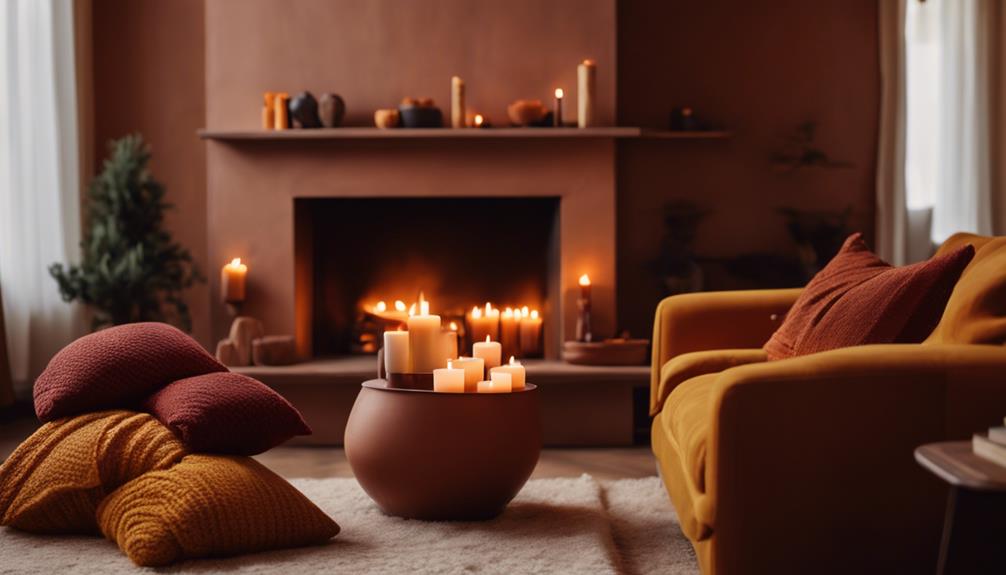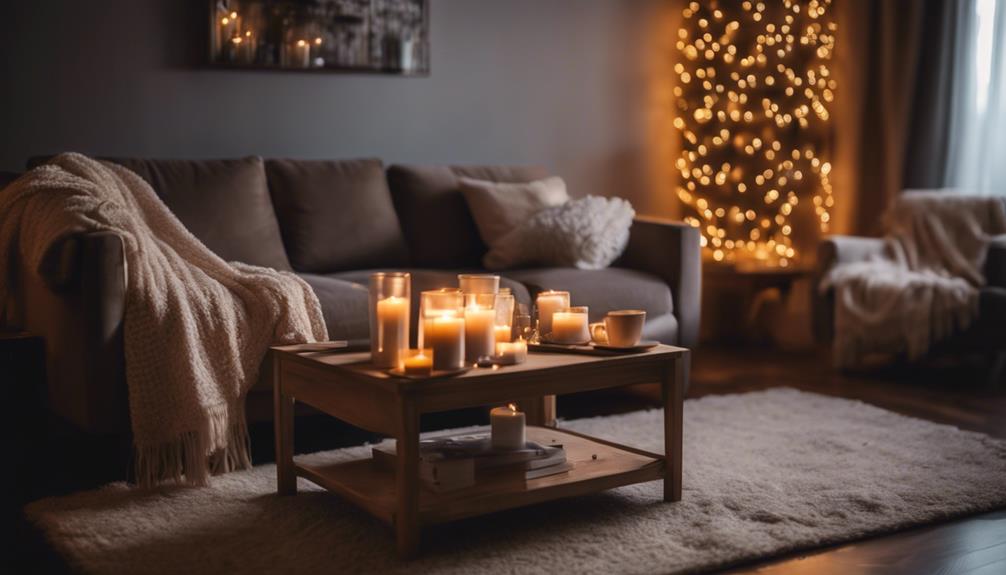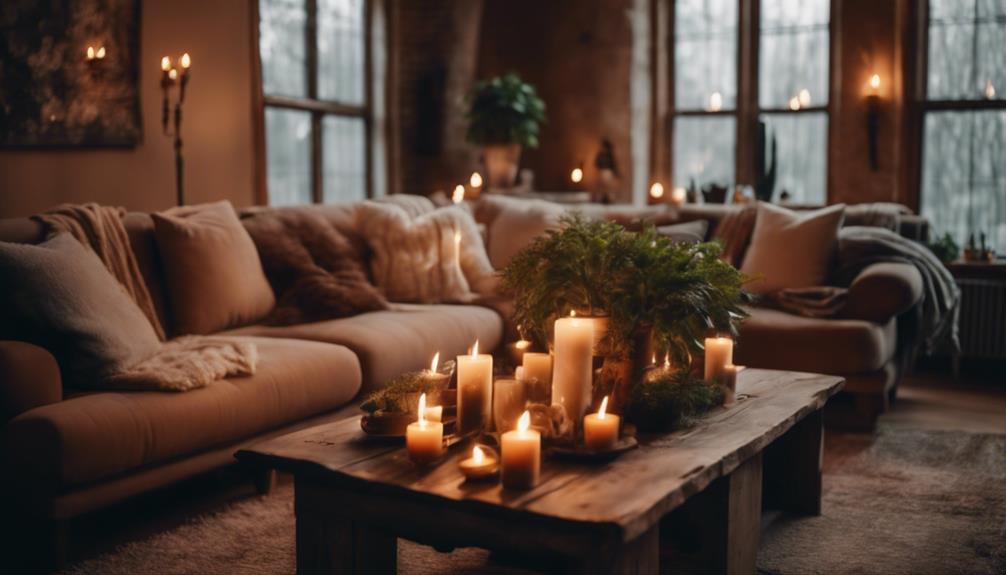Transform your home into a comfortable escape by focusing on welcoming furniture and cozy colors. Opt for chic, minimalist pieces that enhance both comfort and functionality. Arrange your seating in a way that promotes conversation and consider adding oversized chairs for moments of quiet relaxation. Use warm whites on your walls and add a touch of joy with colorful throws and pillows. Create special relaxation areas like a reading nook or meditation corner. Enhance the ambiance with soft, adjustable lighting to create a warm and inviting atmosphere. Simple changes can greatly improve your space, turning it into a true sanctuary for unwinding any time. To enhance your cozy retreat, consider incorporating farmhouse décor ideas such as reclaimed wood accents, hanging plants, and rustic textiles. Mix vintage-inspired pieces with natural materials like wicker or rattan to create a welcoming and homey feel. By blending inviting furniture, warm colors, and farmhouse décor, you can design a cozy retreat that truly reflects your personal style and offers a peaceful escape from the outside world.
Key Takeaways
- Select stylish, minimalist furniture with clean lines and neutral colors to create a calming atmosphere in your home.
- Arrange seating to encourage conversation and ensure ample space for movement to maintain an open feel.
- Incorporate warm whites and joyful accent colors through decor elements like throws and pillows for visual interest.
- Designate cozy relaxation spaces like reading nooks or meditation areas to enhance comfort and tranquility.
Cozy Minimalist Furniture

To create a cozy retreat, choose stylish, minimalist furniture that enhances comfort without overwhelming your space. Look for pieces that reflect your personal taste while prioritizing quality and functionality.
Opt for clean lines and neutral colors to maintain a calming atmosphere. Limit your decor items to avoid clutter—select a few standout pieces that resonate with you. This balance will make your space feel inviting and spacious.
Consider multifunctional furniture, like an ottoman that doubles as storage, to maximize utility. Remember, each item should serve a purpose while contributing to the overall aesthetic.
Strategic Furniture Arrangement
Arranging your furniture thoughtfully can transform your space into a cozy retreat that encourages conversation and relaxation.
Position your seating to face each other, creating an inviting atmosphere for discussion.
Consider adding oversized chairs in quieter corners to establish a retreat area for reading or unwinding.
Think about the purpose of each room; your layout should enhance functionality while maintaining comfort.
Verify your furniture complements the room's scale; oversized pieces in a small space can feel cramped.
Avoid overcrowding by leaving enough space for movement, allowing your home to feel open and welcoming.
With these strategic arrangements, you'll foster an environment that invites both connection and tranquility, making your home a true haven.
Warm Color Palette

A warm color palette can instantly transform your home, creating an inviting atmosphere that feels both cozy and uplifting. By selecting the right colors, you can enhance your space in a few simple ways:
- Walls: Use warm whites to reflect natural light, making your rooms feel brighter and more open.
- Textiles: Incorporate joyful colors through throws and pillows, adding pops of vibrancy to your decor.
- Artwork: Choose wall art that reflects your preferred color schemes, tying your overall design together.
Balancing neutral tones with these lively accents creates visual interest without overwhelming your space.
Embrace a warm color palette, and watch your home transform into a delightful retreat where you can relax and unwind.
Dedicated Relaxation Spaces
Creating dedicated relaxation spaces enhances your home's inviting atmosphere, allowing you to unwind and recharge in comfort. Consider setting up a cozy reading nook with your favorite books, or carve out an area for yoga and meditation. Each space should invite tranquility and mindfulness, promoting a soothing retreat from daily stressors.
Here's a simple table to help you visualize potential relaxation spaces:
| Space Type | Key Elements | Purpose |
|---|---|---|
| Reading Nook | Comfy chair, books, soft light | Escape into literature |
| Meditation Area | Mat, cushions, calming decor | Foster mindfulness |
| Yoga Corner | Yoga mat, blocks, calming music | Promote physical wellness |
| Outdoor Retreat | Comfortable seating, plants | Connect with nature |
| Cozy Corner | Pillows, throws, warm light | Relax and recharge |
Mood Lighting Enhancement

Enhancing the mood with thoughtful lighting transforms your space into a warm and inviting haven. You can create the perfect atmosphere by strategically layering your lighting.
Here are three effective ways to enhance your home's mood lighting:
- Use Dimmable Lights: Adjust the brightness to match your activities, whether it's a cozy movie night or a vibrant gathering with friends.
- Incorporate Soft Lighting: Add lamps in darker corners and use fairy lights or candles to create a gentle, welcoming glow.
- Position for Purpose: Arrange your lighting to facilitate evening activities, like reading in your favorite nook or enjoying a glass of wine.
Conclusion
By transforming your home into a cozy retreat, you're not just enhancing your space; you're improving your well-being. Autumn is the perfect time to embrace a warm and inviting atmosphere, and there are many autumnal home decor ideas that can bring a sense of comfort and relaxation to your living space. From incorporating rich, earthy tones and soft textures to adding seasonal touches like pumpkins and warm, ambient lighting, these small changes can make a big difference in your overall sense of contentment and tranquility. By creating a cozy retreat within your home, you are creating a space that promotes self-care, relaxation, and a sense of sanctuary in the midst of life’s hustle and bustle. Additionally, investing in stylish and functional furniture can help create a cozy retreat. Consider adding a plush armchair or a comfortable sofa with soft throws and pillows to encourage relaxation and lounging. Creating a designated area for reading or enjoying a cup of tea can also contribute to the overall coziness of your space. By combining these elements with autumnal decor, you can transform your home into a warm and inviting sanctuary for the season.
Studies show that a well-designed environment can boost your mood by up to 30%.
So, as you embrace cozy minimalist furniture, warm colors, and dedicated relaxation areas, remember that each choice contributes to your happiness.
Take the time to curate your sanctuary, and you'll find it becomes a cherished escape from the hustle and bustle of daily life.









